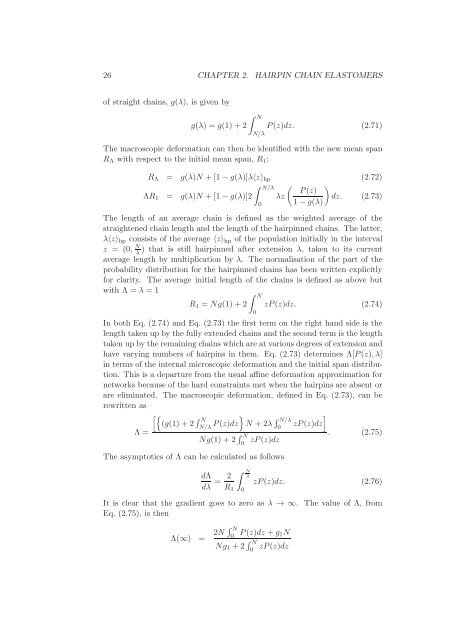Statistical models of elasticity in main chain and smectic liquid ...
Statistical models of elasticity in main chain and smectic liquid ...
Statistical models of elasticity in main chain and smectic liquid ...
You also want an ePaper? Increase the reach of your titles
YUMPU automatically turns print PDFs into web optimized ePapers that Google loves.
26 CHAPTER 2. HAIRPIN CHAIN ELASTOMERS<strong>of</strong> straight cha<strong>in</strong>s, g(λ), is given by∫ Ng(λ) = g(1)+2 P(z)dz. (2.71)N/λThe macroscopic deformation can then be identified with the new mean spanR Λ with respect to the <strong>in</strong>itial mean span, R 1 :R Λ = g(λ)N +[1−g(λ)]λ〈z〉 hp (2.72)∫ N/λ( ) P(z)ΛR 1 = g(λ)N +[1−g(λ)]2 λz dz. (2.73)1−g(λ)The length <strong>of</strong> an average cha<strong>in</strong> is def<strong>in</strong>ed as the weighted average <strong>of</strong> thestraightened cha<strong>in</strong> length <strong>and</strong> the length <strong>of</strong> the hairp<strong>in</strong>ned cha<strong>in</strong>s. The latter,λ〈z〉 hp consists <strong>of</strong> the average 〈z〉 hp <strong>of</strong> the population <strong>in</strong>itially <strong>in</strong> the <strong>in</strong>tervalz = (0, N λ) that is still hairp<strong>in</strong>ned after extension λ, taken to its currentaverage length by multiplication by λ. The normalisation <strong>of</strong> the part <strong>of</strong> theprobability distribution for the hairp<strong>in</strong>ned cha<strong>in</strong>s has been written explicitlyfor clarity. The average <strong>in</strong>itial length <strong>of</strong> the cha<strong>in</strong>s is def<strong>in</strong>ed as above butwith Λ = λ = 10∫ NR 1 = Ng(1)+2 zP(z)dz. (2.74)0In both Eq. (2.74) <strong>and</strong> Eq. (2.73) the first term on the right h<strong>and</strong> side is thelength taken up by the fully extended cha<strong>in</strong>s <strong>and</strong> the second term is the lengthtaken upbytherema<strong>in</strong><strong>in</strong>gcha<strong>in</strong>swhichareat various degrees <strong>of</strong>extension <strong>and</strong>have vary<strong>in</strong>g numbers <strong>of</strong> hairp<strong>in</strong>s <strong>in</strong> them. Eq. (2.73) determ<strong>in</strong>es Λ[P(z),λ]<strong>in</strong> terms <strong>of</strong> the <strong>in</strong>ternal microscopic deformation <strong>and</strong> the <strong>in</strong>itial span distribution.This is a departure from the usual aff<strong>in</strong>e deformation approximation fornetworks because <strong>of</strong> the hard constra<strong>in</strong>ts met when the hairp<strong>in</strong>s are absent orare elim<strong>in</strong>ated. The macroscopic deformation, def<strong>in</strong>ed <strong>in</strong> Eq. (2.73), can berewritten as[{(g(1)+2 ∫ }NN/λ P(z)dz N +2λ ∫ ]N/λ0zP(z)dzΛ =Ng(1)+2 ∫ N0 zP(z)dz . (2.75)The asymptotics <strong>of</strong> Λ can be calculated as followsdΛdλ = 2 ∫ NλR 10zP(z)dz. (2.76)It is clear that the gradient goes to zero as λ → ∞. The value <strong>of</strong> Λ, fromEq. (2.75), is thenΛ(∞) = 2N ∫ N0 P(z)dz +g 1NNg 1 +2 ∫ N0 zP(z)dz
















